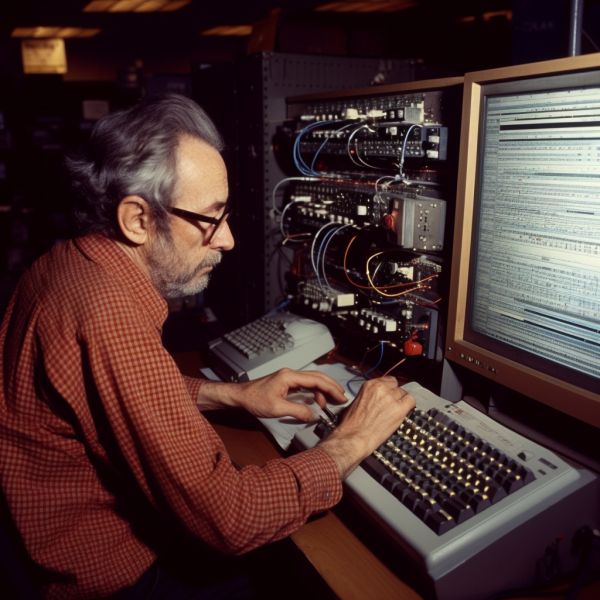
More realistic (but still imaginary) senior COBOL developer. Get them while they last! Or use ChatGPT instead, I suppose, if your business is fault-tolerant.
Zorin OS looks reasonably Windows-like once you select the right theme, but to be honest it seems slightly slower than Windows 10, at least when opening programs. The mouse pointer will also freeze randomly and fairly often on my Acer Nitro 5, although it starts moving again if I press any key or scroll with the mouse wheel. But it is clean and low on distractions, and as a bonus, it is far less exposed to viruses, spyware, ransomware, and other creepy stuff. When Linux geeks assure you that their grandma loves Linux, they are not actually lying. It just so happens that their grandma mostly uses the PC to read and answer emails, maybe surf the web, and watch pictures of her grandkids. But we all know that Linux is really made for people who don’t want things to be easy.
Case in point, installing gnuCOBOL, a free compiler for the COBOL programming language. COBOL was popular on big “mainframe” computers in the 1960es and still survives here and there. The code is largely self-documenting and easy to read, with intuitive English-like phrases like SUBTRACT REBATE FROM PRICE. So you would reasonably expect it to be easy to install as well. Perhaps download an installer from the website, double-click on it, and go make a sandwich while it installs? Haha no, this is open-source software, made by autistic people for autistic people. We would not give normies that kind of power without them working for it. If at all.
Actually, it does not look that hard looking back, but that is because ChatGPT told me what to do step by step. (Well, I actually did download the package file on my own.) Interestingly, it still took a couple attempts. ChatGPT told me what dependencies to install first (that would be other pieces of software that gnuCOBOL depends on), but it forgot two, which I had to install later. In all fairness, this became obvious during the installation process, more exactly after I gave the command ./configure while standing in the unpacked folder. This command does the reasonable thing and checks for dependencies, so if you know what’s going on, you can install the missing dependencies on this stage. Of course, if you’re a normie and used to software coming with installers, you don’t know what goes on. I suppose a small script could have automated the process, but then any random normie could install your software without being bathed in a cold sweat. And we wouldn’t want that. Normies deserve to suffer.
Anyway, the meat of the install process is running this little sequence in the unpacked folder:
./configure
make
sudo make install
sudo ldconfig
where the “./configure” part will list any missing components (which you must add with “sudo apt-get install” and the proper name, which it will not necessarily tell you). Once that runs without errors, the “make” will try to compile the new software, the “sudo make install” will try to put it in your system, and the “ldconfig” will update the shared library cache. Or that’s how ChatGPT explained it. But if you had been worthy, you would have known this already. That said, ChatGPT which is currently as smart as a lawyer, still had to make three attempts while adjusting for error messages, before the “cobc” – COBOL compiler – finally was ready to use.
If even this explanation just looks like a wall of gibberish, that is sort of the point. Normies, muggles, neurotypicals or Untermenschen, whatever you call the human majority: They are not supposed to be able to do this. Let them stick to Windows and make spreadsheets while Windows keeps trying to take over the screen and tell them of other people’s coronation and how Microsoft Edge is the only safe way to browse the Web.
But ChatGPT has changed all that… a little, at least. I mean, it took 3 attempts, and I am not quite neurotypical myself and have dabbled briefly in various operating systems over the decades, including some Linuxes. And ChatGPT-4 is still only smarter than 80% of lawyers, from what I hear. (Let the lawyer jokes begin… if you are willing to risk being sued.) In all fairness, I would not ask the average lawyer to install a COBOL compiler on a little-used operating system, either. More realistically, they would ask me.
Next I was planning to tell about the somewhat similar adventures of trying to install an IDE – and integrated development environment – where our ever-helpful Artificial Intelligence threw up its metaphorical hands because things had changed since it was trained in 2021, and we installed a different IDE instead. (Things have changed since I graduated in 1977 as well.) But the next day the news broke that we folks who pay for ChatGPT will be able to let it fetch information on the Web. If this works (and is enabled in Europe, which is a big if) that would mean a major power-up for our friendly Large Language Model. Who knows, it might even become able to install software under Linux on the first try. That would certainly put it ahead of most humans.

